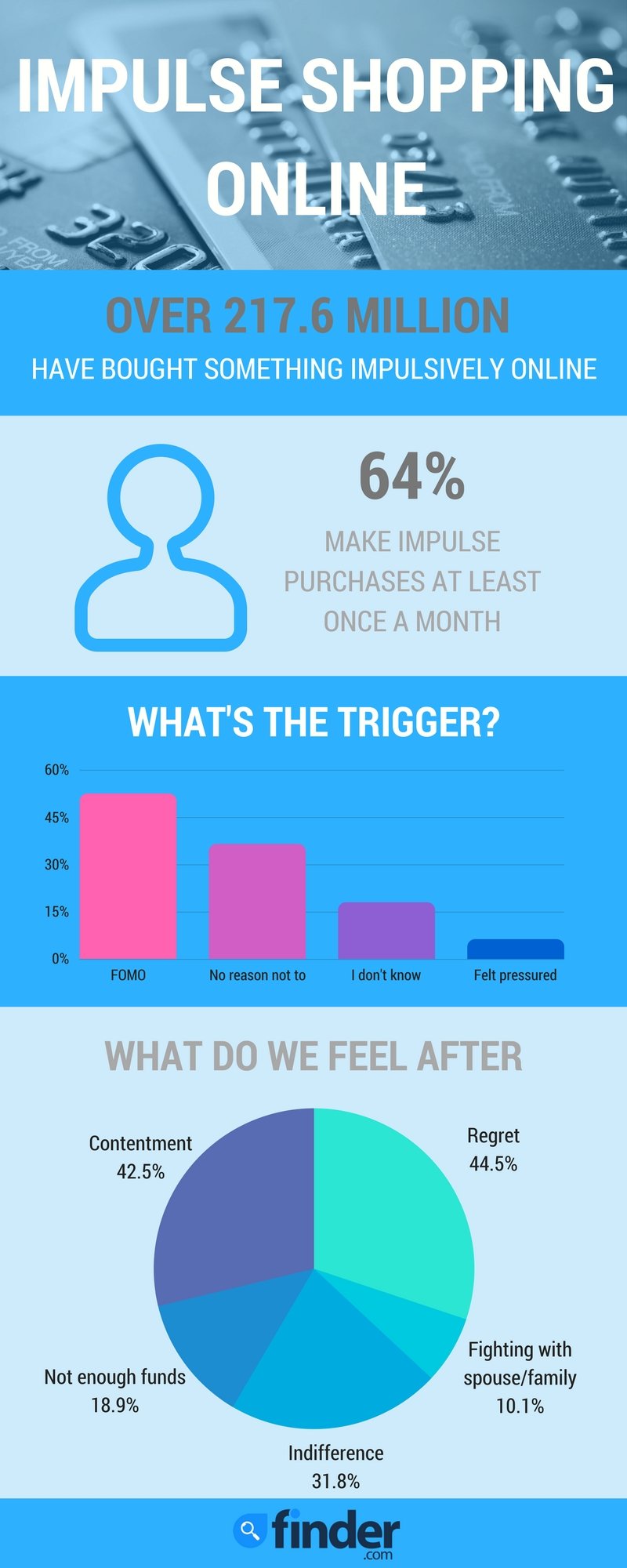You might be interested in
- Top retail credit cards
- Find the best promo codes
Thanks to the digital age, we now have more ways to shop than ever before. However, such convenience and choice comes with the potential to fall prey to spending more than we initially intended. According to a recent finder.com survey, 88.6% of American adults have succumbed to impulsive online shopping, with each person spending on average $81.75 per session. That equates to a whopping $17.78 billion spend.
In July 2017, we commissioned a study of 2,245 Americans conducted by global research provider pureprofile to learn more about impulsive shopping habits. Of those surveyed who make impulsive purchases, regret is their number one post-shopping issue. It’s apparent that we need more than simple willpower to say ‘no’ to unnecessary spending.
Enter Icebox, an innovative, easy-to-use tool that can help you curb your impulse purchases. Developed and released by finder.com, the free Icebox Chrome extension aims to reduce the feelings of regret that nearly half of Americans (44.5%) say they experience as a result of impulse spending, encouraging you to put your purchases on ice for up to 30 days. Combat your impulsive shopping by installing Icebox today!

The majority of impulsive online shoppers make spontaneous purchases at least once a month (64.0%). Some people have a serious problem, with 6.7% admitting to impulsive shopping every day! More than 1 in 5 say they make impulsive purchases every week, while 17.9% do so every few months.
| Frequency of impulsive online purchases | Proportion of impulsive online shoppers |
|---|---|
| Daily | 6.7% |
| Weekly | 22.1% |
| Monthly | 35.2% |
| Every 3 months | 17.9% |
| Every 6 months | 9.1% |
| Every year | 6.0% |
| Every few years | 3.0% |
Source: finder.com
Interestingly, more men (67.2%) admitted to impulsive online spending than women (62.6%). Men are also more likely to have a daily impulsive shopping habit (11.0%) compared to women (4.8%). Men spend more money on their online impulsive shopping per session than women, with average purchases sitting at $105.35, compared to $70.97 for the ladies.
| Frequency of impulsive online purchases | Female | Male |
|---|---|---|
| Daily | 4.8% | 11.0% |
| Weekly | 21.3% | 23.7% |
| Monthly | 36.5% | 32.5% |
| Every 3 months | 19.7% | 14.1% |
| Every 6 months | 8.9% | 9.3% |
| Every year | 6.1% | 5.9% |
| Every few years | 2.7% | 3.5% |
Source: finder.com
Millennials admit to impulse spending more than any other generation, with 8.4% of them likely to have a daily online shopping habit, followed by 6.1% of Gen X and 1.3% of Baby Boomers. Interestingly, Baby Boomers are actually spending the most per session in their online impulse shop, sitting at an average of $174.25, more than double Millennials at $82.37 and Gen Xers at $65.56.
Those married or in a domestic partnership (30.9%) are the most likely to be making impulsive online purchases weekly, followed by single people (28.9%), those separated (25.0%), divorcees (21.4%) and widows (12.2%). When it comes to spending up big, those separated making the most expensive splurges, with average spending at $113.00 per session, followed by those who are married or in domestic partnerships ($97.89), single people ($69.28), divorcees ($60.84) and widows ($47.94).
Those residing in Florida (13.6%) are the most likely to have a daily online shopping habit, followed by Ohio (11.5%) and Illinois (11.1%), of the 17 qualifying states (those with a minimum of 40 respondents from the sample). The top three ranked by highest averages per session are Florida at $232.87 per session, followed by Michigan at $158.39 and Alabama at $134.23.
If you feel a sense of regret after splurging, you’re not alone! Of those who are guilty of impulsive shopping, regret is the leading feeling after a session, experienced by 44.5% of those we surveyed. Interestingly, regret is closely followed by contentment (42.5%); indifference (31.8%); feeling as though they didn’t have enough funds for rent, school fees, loan repayments or something else they actually needed (18.9%); and fighting with a spouse or family member (10.1%).
Despite the popularity of online shopping, impulsive in-store purchases still lead the way for now, with 95.0% of Americans admitting to splurging in store compared to the 88.6% at an online checkout. On average, Americans say farewell to $85.85 per in-store impulsive purchase, a few dollars more than they do per online session, which comes in at $81.75. As online retailers become more competitive and convenient, we anticipate this trend will shift in the very near future.
The main trigger for impulsive purchases in America is fear of missing out — on a deal, on something in stock or on an item we might forget about — admitted by 52.5% of those we surveyed. This is followed by simply having no good reason not to make the purchase (36.5%), being unsure about the purchase (18.0%) and feeling pressured to make the purchase by friends, a store clerk or online prompts (6.3%).

Richard Laycock, Insights editor and senior content marketing manager